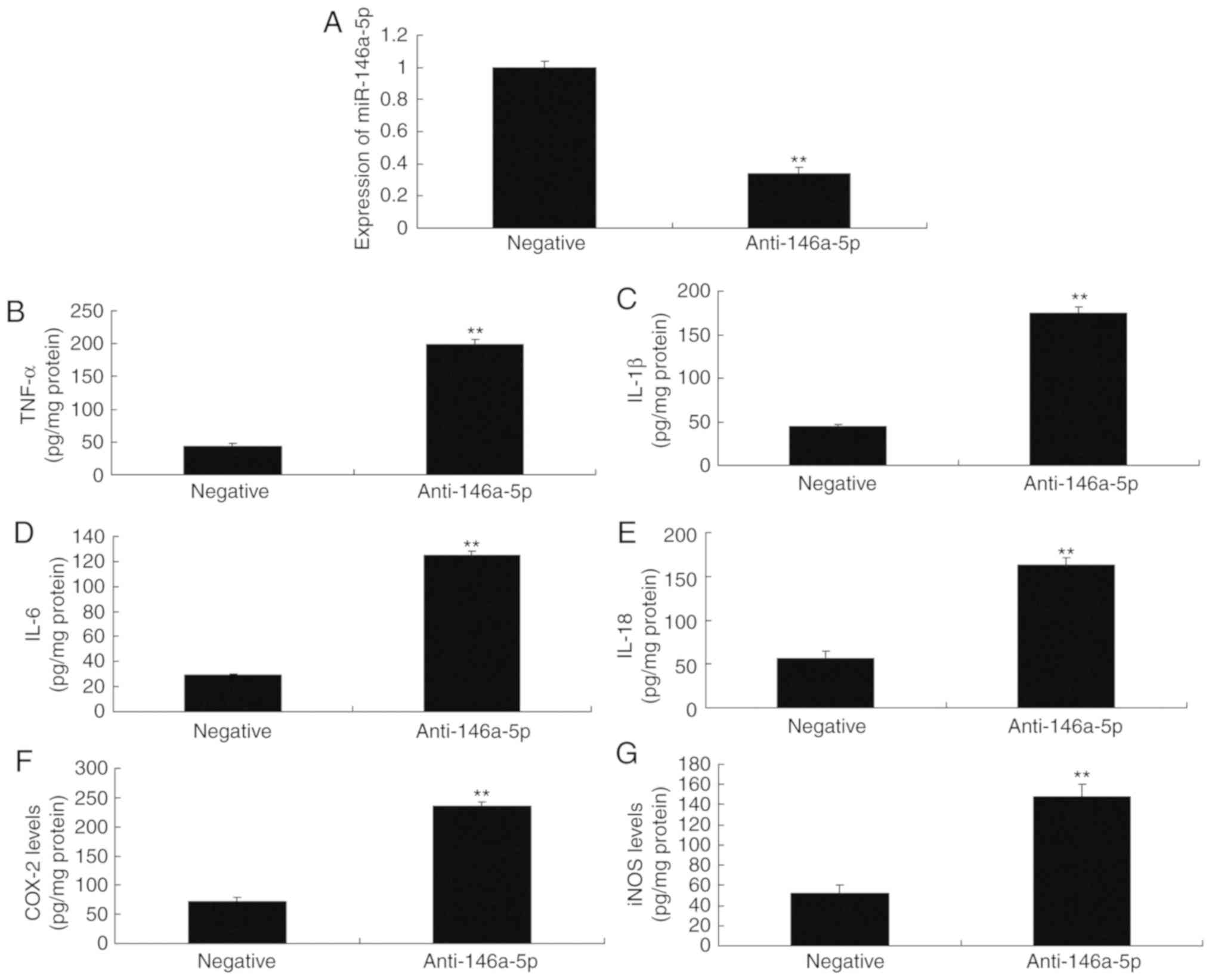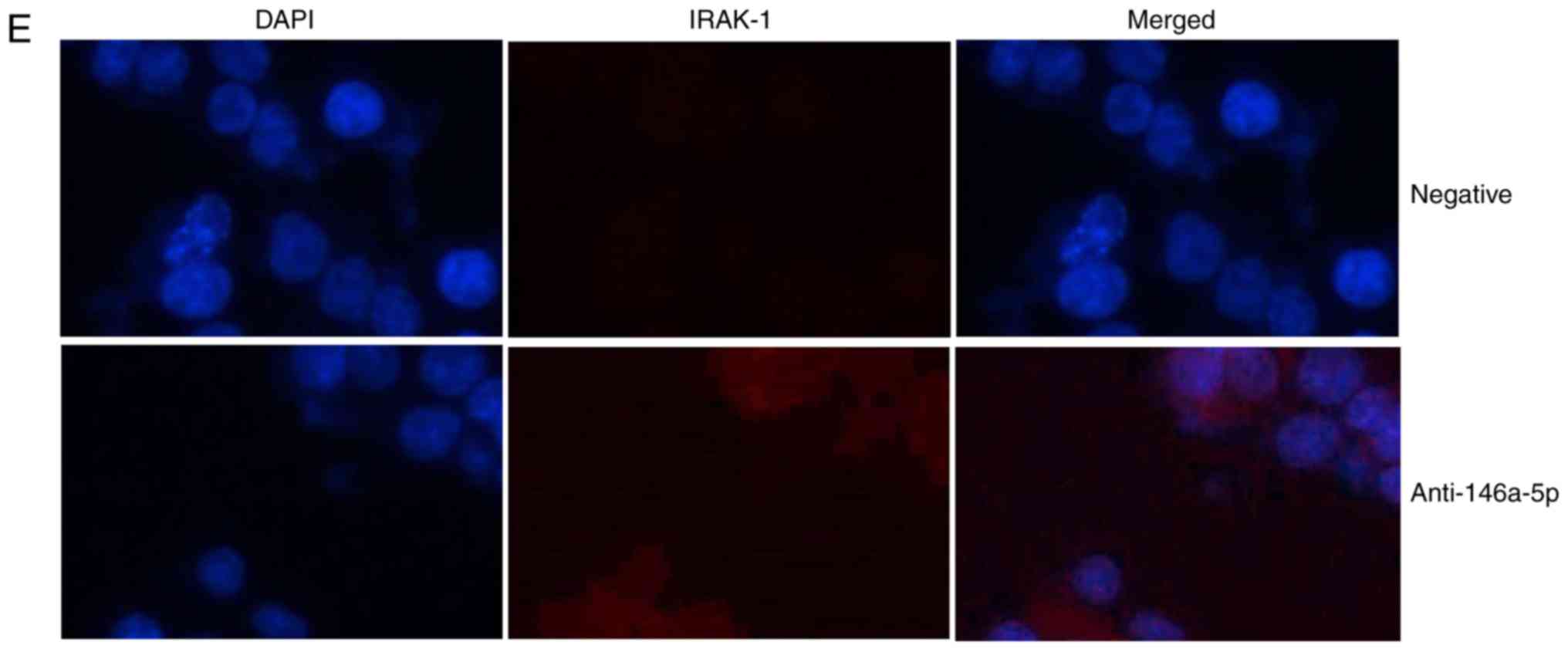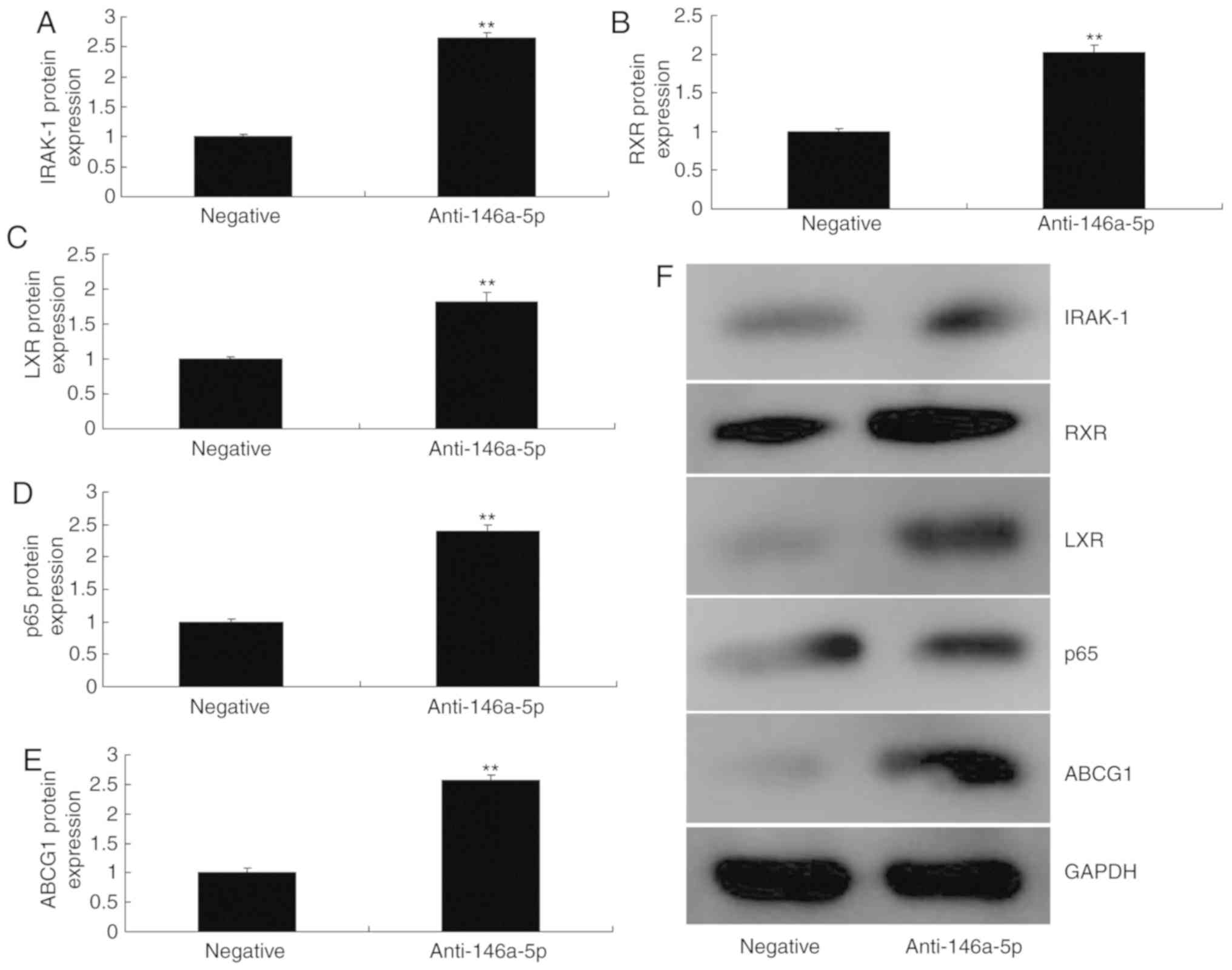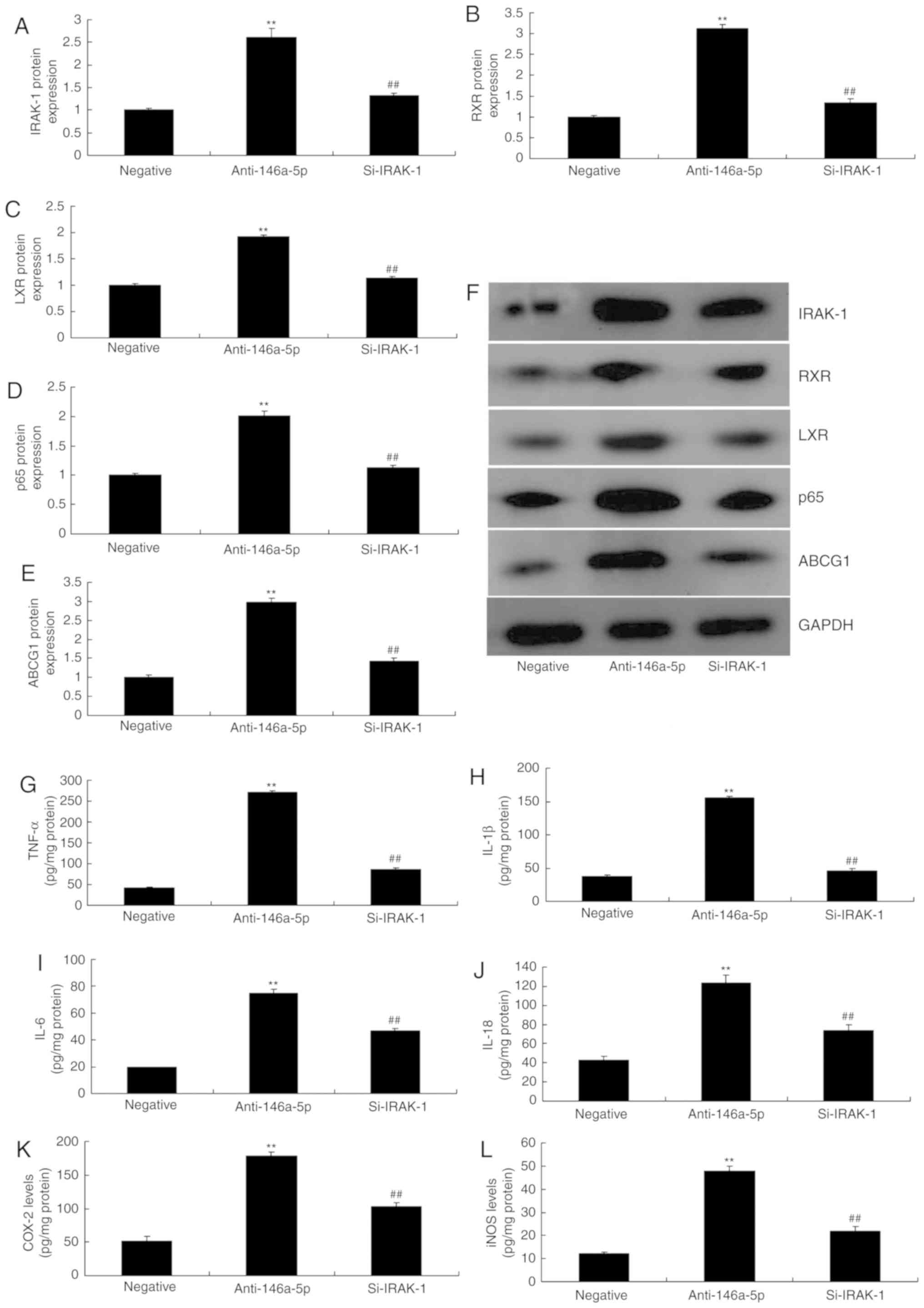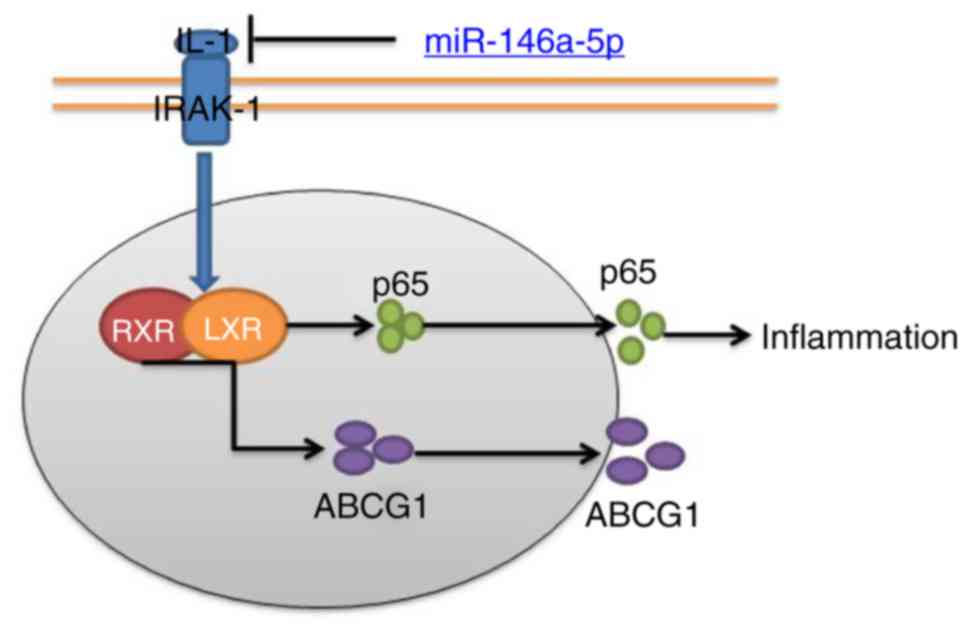miR‑146a‑5p suppresses ATP‑binding cassette subfamily G member 1 dysregulation in patients with refractory Mycoplasma pneumoniae via interleukin 1 receptor‑associated kinase 1 downregulation
- Authors:
- Published online on: October 22, 2019 https://doi.org/10.3892/ijmm.2019.4380
- Pages: 2003-2014
-
Copyright: © Li et al. This is an open access article distributed under the terms of Creative Commons Attribution License.
Abstract
Introduction
Mycoplasma pneumoniae pneumonia (MPP), a common acute respiratory tract infectious disease in children that has a variety of clinical manifestations, is caused by Mycoplasma pneumoniae (MP) infection, and can lead to multi-organ and multi-system damage (1). In recent years, the cases of refractory MPP (RMPP) are increasing annually. Additionally, the risk of extra-pulmonary complications is elevated, which can severely affect the health of patients (1). MPP affects the quality of life of children and their families; therefore clinical investigations into this disease is required (2,3).
MicroRNA (miRNA/miR) can regulate gene expression by activating or suppressing gene transcription, serving a key role in physiological development, as well as the development of disease (4). Additionally, miRNA not only exerts a crucial part in cell differentiation and organ development (5), but can also serve as a molecular marker for various physiological and pathological states (5). Numerous studies indicated that miRNAs are closely associated with the genesis, development and prognosis of pulmonary infection (6,7); however, no intensive studies have been performed, yet further investigation is required (6). On the contrary, research into miRNAs have provided notable insight into the molecular mechanism, clinical diagnosis and treatment for pulmonary infectious disease (6). Osei et al (8) revealed that decreased levels of miR-146a-5p in chronic obstructive pulmonary disease-associated fibroblasts may induce a more pronounced pro-inflammatory phenotype. Pradhan et al reported that miRNAs interfere with translation of their target gene and regulate a variety of biological actions exerted by these target genes (9).
Member 1 of human transporter subfamily (ABCA1) and ATP-binding cassette subfamily G member 1 (ABCG1) belong to the ATP binding cassette transporter (ABC) superfamily, whose main function is to promote the outflow of intracellular free cholesterol (10). The ABCA1- and ABCG1-regulated cholesterol outflow from macrophages is key step in preventing and reversing foam cell formation (10).
The ABCA1- and ABCG1-regulated cholesterol outflow from macrophages serves a key role in scavenging excessive cholesterol in tissues, including vascular walls (11,12). Therefore, dysfunctions in ABCA1 and ABCG1 may lead to excessive cholesterol accumulation in macrophages, forming foam cells, which subsequently invade the vascular wall and promote MPP genesis and development (11,12).
Interleukin (IL)-1 receptor-associated kinases (IRAKs) are the members with similar composition and structure of serine-threonine; four members have been reported as of yet, including IRAK-1, IRAK-2, IRAK-M and IRAK-4 (13). Among them, only IRAK-1 and IRAK-4 possess kinase activity, while IRAK-4 is considered as an essential factor required to activate the Toll-IL receptor and myeloid differentiation primary response 88 (MyD88)-dependent pathway (13,14). Following the phosphorylation processes in the aforementioned pathways, IRAKs dissociate from MyD88, and bind with tumor necrosis factor receptor (TNF) associated factor 6 (TRAF6) to form an IRAK1-TRAF6 complex (14). Subsequently, nuclear factor-κB (NF-κB) and transcription factor activated activator protein-1 are activated, while the release of pro-inflammatory cytokines, including IL-6, IL-1 and TNF-α is promoted, inducing the downstream cascade of inflammatory reactions, resulting in tissue inflammatory injury (15). Li et al (16) revealed that miR-146a-5p antagonized advanced glycation end products (AGEs)- and Porphyromonas gingivalis (P.g)-LPS-induced ABCA1 and ABCG1 dysregulation in macrophages via IRAK-1 downregulation (16). In the present study, the function of miR-146a-5p in patients with refractory MPP was investigated.
Materials and methods
Patients with MPP
Children diagnosed (male, n=10; female, n=10) with MPP were enrolled from Renmin Hospital. The age range was 1 month to 12 years. The peripheral blood of all patients was collected, and patients underwent chest radiography and M. pneumonia tests, including specific IgM in by ELISA. The exclusion criteria for the enrollment of patients were: i) Those with congenital heart diseases, hereditary metabolic diseases, neurological disorders, bronchopulmonary dysplasia, and immunodeficiency; and ii) patients co-infected with other pathogens. The present study was approved by the Ethics Committee of Renmin Hospital, Hubei University of Medicine. Written informed consent obtained from pthe family of patients.
Quantification of miRNA level. Total RNA was extracted from lung tissue or cell samples using TRIzol reagent (Thermo Fisher Scientific, Inc.) and cDNA was obtained using a RevertAid First Strand cDNA Synthesis kit (Thermo Fisher Scientific, Inc.) at 42°C for 60 min and 82°C for 10 sec. 500 ng RNA was labeled and using an equimolar concentration of Cyanine-3-CTP-labelled universal mouse reference (Stratagene). miRNA analysis was performed on an ABI 7500 real-time PCR system (Applied Biosystems; Thermo Fisher Scientific, Inc) using TaqMan Universal PCR Master Mix (Thermo Fisher Scientific, Inc.). miRNA expression levels were calculated using an endogenous control with the 2−ΔΔCq method (17). PCR amplification conditions were as follows: Initial denaturation at 95°C for 10 min, 40 cycles of 95°C for 30 sec, 60°C for 30 sec, 72°C for 30 sec. Sequence information: miR-146a-5p: Forward, 5′-GGG GTG AGA ACT GAA TTC CAT-3′ and reverse, 5′-CAG TGC GTG TCG TGG AGT-3′; U6: Forward, 5′-GCT TCG GCA GCA CAT ATA CTA AAA T-3′ and reverse, 5′-CGC TTC ACG AAT TTG CGT GTC AT-3′. Data were examined using Genespring 12.6.1 (Agilent Technologies) and Agilent Feature Extraction Software (version A.10.7.3.1).
Gene chip analysis
The total RNA was extracted using mirVana™ miRNA Isolation kit (Ambion; Thermo Fisher Scientific, Inc.). The Agilent Human miRNA array (8*60K, V16.0, Agilent Technologies, Inc.) and total RNA was labeled by Cy-3 using miRNA Complete Labeling and Hyb kit (5190-0456, Agilent Technologies, Inc.). Data was performed by Agilent Microarray Scanner (G2565CA, Agilent Technologies, Inc.) and normalized by Quantile algorithm with Gene Spring Software 12.6 (Agilent Technologies, Inc.).
MPP model, and hematoxylin and eosin staining
Ethical approval was obtained from Renmin Hospital, Hubei University of Medicine. Male C57BL/6 mice (4-5 g, 1 week old, n=20) were purchased from the Animal laboratory of Renmin Hospital. C57BL/6 mice of model group were injected with 2 mg/kg of lipopolysaccharide (LPS, intraperitoneally) for 12 h under anesthesia with 50 mg/kg sodium pentobarbital as reported previously by Fang et al (18). C57BL/6 mice of sham group were injected with 50 mg/kg sodium pentobarbital. Then, mice were sacrificed via decollation whilst anesthetized. Lung tissue samples were collected and fixed with 4% paraformaldehyde for 24 h at room temperature or stored at -80°C.
Lung tissue samples fixed with paraformaldehyde were paraffin-embedded. The samples were cut into 10-µm sections using a paraffin slicing machine (RM2235; Leica Microsystems GmbH), stained with hematoxylin and eosin for 10 min at room temperature, and observed under a light microscope (magnification, ×100, BH3-MJL; Olympus Corporation).
Cell culture
A549 cells was maintained in Dulbecco's Modified Eagle's medium (Gibco; Thermo Fisher Scientific, Inc.) supplemented with 10% fetal bovine serum (Gibco; Thermo Fisher Scientific, Inc.). 100 ng/ml miR-146a-5p (5′-CCG ATA TAT ATC CTC ACT T-3′), anti-miR-146a-5p (5′-ATG GGC TAT ATA GGA GTG AAC C-3′) and negative mimics (5′-TTC TCC GAA CGT GTC ACG T-3′), small interfering RNA (si)-IRAK-1 (sc-35704, Santa Cruz Biotechnology, Inc.) or si-RXR (sc-36447, Santa Cruz Biotechnology, Inc.) were transfected into cells using Lipofectamine® 2000 for 48 h. After 48 h, cells were treated with 100 ng/ml of LPS for 6 h at 37°C as reported by Guo and Cheng (19).
ELISA kits
Serum samples were centrifuged at 2,000 × g for 20 min at 4°C and cell samples were centrifuged at 1,000 × g for 10 min at 4°C. Serum samples were used to measure the levels of TNF-α (cat. no. H052), IL-1β (cat. no. H002), IL-6 (cat. no. H007) and IL-18 (H015) using ELISA kits (Nanjing Jiancheng Institute of Bioengineering). Cell samples were lysed with radioimmunoprecipitation assay (RIPA; (Beyotime Institute of Biotechnology) and used to measure TNF-α, IL-1β, IL-6 and IL-18 levels using ELISA kits.
Luciferase reporter assay
The network of signaling pathway components revealed that IRAK-1 may targets of miR-146a-5p be important using http://www.targetscan.org/vert_71/.IRAK-1-expressing pc-DNA-3.1 plasmids and anti-miR-146a-5p were co-transfected into cells using Lipofectamine 2000 for 48 h. Reporter activity levels were quantified 48 h after transfection using a Dual-Luciferase Reporter Assay kit (Beyotime Institute of Biotechnology). Measurements were obtained using a Lumat LB 9507 instrument (Berthold Technologies). Normalization was performed via comparisons with Renilla luciferase activity.
Western blotting analysis
Cells were harvested and lysed in RIPA buffer. Protein content was measured using a BCA assay (Beyotime Institute of Biotechnology). Protein (50 µg) was separated via 10% SDS-PAGE and transferred to poly-vinylidene difluoride membranes, which were washed in Tris-buffered saline with Tween-20 (TBST) for three times and blocked with 5% non-fat in TBST for 1 h at room temperature. Subsequently, the membranes were incubated with antibodies against ABCG1 (ab218528, 1:1,000, Abcam), IRAK-1 (sc-515512, 1:1,000, Santa Cruz Biotechnology, Inc.), retinoid X receptor (RXR, sc-46659, 1:1,000, Santa Cruz Biotechnology, Inc.), liver X receptor (LXR, sc-271064, 1:1,000, Santa Cruz Biotechnology, Inc.) and GAPDH (sc-69778, 1:5,000, Santa Cruz Biotechnology, Inc.) at 4°C overnight. The membrane was washed three times with TBST for 15 min and incubated with a horseradish peroxidase-conjugated secondary antibody (sc-2004, 1:5,000, Santa Cruz Biotechnology, Inc.) at 37°C for 1 h. Proteins were detected by Super Signal chemiluminescent reagent (Thermo Fisher Scientific, Inc.) and measured using Flowjo 7.6.1 (FlowJo, LLC).
Immunofluorescence (IF)
Cells were washed with PBS and fixed with 4% paraformaldehyde for 20 min at room temperature. Cells were blocked with 5% bovine serum albumin (Beyotime Institute of Biotechnology) and 0.1% Triton X-100 for 1 h and incubated with anti-IRAK-1 (Santa Cruz Biotechnology, Inc.) at 4°C overnight. Cells were washed with PBS and incubated with goat anti-rabbit IgG-CFL 555 (Santa Cruz Biotechnology, Inc.) for 1 h at room temperature. Cells were washed with PBS and stained with DAPI for 15 min at room temperature. Then, cells were washed with PBS and observed under a light microscope (magnification, ×100, BH3-MJL; Olympus Corporation).
Statistical analysis
Data are presented as the mean ± standard deviation. Statistical significance between groups was determined by a Student's t-test or one-way analysis of variance followed by a Tukey's post-hoc test. P<0.05 was considered to indicate a statistically significant difference.
Results
Expression of miR-146a-5p in patients or mice with refractory MPP
To investigate the effects of miR-146a-5p in a mouse model with refractory MPP, we first analyzed changes in the expression of miR-146a-5p in a mouse model with refractory MPP. The results revealed that the expression serum levels of TNF-α, IL-1β, IL-6 and IL-18 were significantly increased in MPP mice, compared with sham mice (Fig. 1A-D). H&E staining showed that pulmonary alveoli were smaller in the MPP mouse model, compared with sham mice (Fig. 1E). In addition, the expression of miR-146a-5p was significantly reduced in mice with refractory MPP, compared with the sham group (Fig. 1F and G). Consistently, miR-146a-5p expression was significantly downregulated in patients with refractory MPP compared with the control normal group (Fig. 1H). Therefore, miR-146a-5p may serve a role in the inflammation associated with refractory MPP.
miR-146a-5p regulates inflammation in an in vitro model of refractory MPP
Then, downregulation of miR-146a-5p significantly increased the levels of TNF-α, IL-1β, IL-6 and IL-18 in an in vitro model of refractory MPP, compared with negative control group (Fig. 2). However, overexpression of miR-146a-5p significantly reduced the levels of TNF-α, IL-1β, IL-6 and IL-18 in an in vitro model of refractory MPP compared with the negative control group (Fig. 3). These results suggested that miR-146a-5p was involved in the inflammation associated with MPP in vitro.
miR-146a-5p regulates the protein expression of ABCG1/IRAK-1 in an in vitro model of refractory MPP
To confirm the mechanism of miR-146a-5p in inflammation in an in vitro model of refractory MPP, miR-146a-5p and anti-miR-146a-5p mimics were respectively transfected into cells. Gene chip analysis revealed that the protein expression levels of ABCG1 and IRAK-1 were increased in an in vitro model of refractory MPP following down-regulation of miR-146a-5p, compared with the negative group (Fig. 4A). The 3-untranslated region of IRAK-1 is complementary to the seed sequence of anti-miR-146a-5p; the luciferase activity levels were significantly increased in an in vitro model of refractory MPP following down-regulation of miR-146a-5p, compared with the negative control group (Fig. 4B and C). The network of signaling pathway components revealed that ABCG1 and IRAK-1 may be important in the development of MPP (Fig. 4D) using http://www.targetscan.org/vert_71/. These results of IF analysis revealed that IRAK-1 protein expression was induced in an in vitro model of refractory MPP following downregulation of miR-146-5p compared with the negative control group (Fig. 4E). Upregulation of miR-146a-5p significantly reduced the protein expression of IRAK-1, RXR, LXR, p65 and ABCG1 in an in vitro model of refractory MPP in comparison with the negative control group (Fig. 5). However, downregulation of miR-146a-5p significantly increased the protein expression of IRAK-1, RXR, LXR, p65 and ABCG1 in an in vitro model of refractory MPP, compared with the negative control group (Fig. 6).
Small interfering RNA (si)-IRAK-1 attenuates the effects of miR-146a-5p on inflammation and ABCG1 in an in vitro model of refractory MPP
To evaluate the function of IRAK-1 in the effects of miRNA-146a-5p on inflammation in an in vitro model of infantile pneumonia, si-IRAK-1 was used to downregulate the protein expression of IRAK-1; the expression levels of RXR, LXR, p65 and ABCG1 were significantly downregulated in an in vitro model of infantile pneumonia, compared with the group transfected with anti-miR-146a-5p (Fig. 7A-F). In addition, the increased levels of TNF-α, IL-1β, IL-6 and IL-18 due to downregulated miR-146a-5p were reduced in an in vitro model of infantile pneumonia following silencing of IRAK-1 expression (Fig. 7G-L).
si-RXR attenuates the effects of miR-146a-5p on inflammation and ABCG1 in an in vitro model of refractory Mycoplasma Pneumoniae pneumonia
Finally, si-RXR was used to suppress the protein expression of RXR, LXR, p65 and ABCG1 in an in vitro model of refractory MPP following downregulation of miR-146a-5p. Compared with the anti-miR-146a-5p transfected group, silencing of RXR expression significantly suppressed the expression of the aforementioned proteins (Fig. 8A-E). In addition, down-regulation of RXR significantly attenuated the effects of anti-miR-146a-5p on the levels of TNF-α, IL-1β, IL-6 and IL-18 in an in vitro model of refractory MPP (Fig. 8F-K). Overall, the results demonstrated that miR-146a-5p may be critical for inflammation and the expression of ABCG1 in an in vitro model of refractory MPP.
Discussion
RMPP is a type of MPP, which cannot be alleviated with macrolide antibiotics; instead, RMPP rapidly develops into a form of intra-pulmonary disease, thereby potentially inducing various extra-pulmonary complications as a life-threatening condition (19). Therefore, early diagnosis and treatment are problems to overcome, yet the precise pathogenesis and regulatory factors of MP infection remain unclear (20). Previously, the role of pattern recognition receptors in MP infection has attracted wide attention (20). Our findings demonstrated that miR-146a-5p expression was inhibited in patients with refractory MPP. Osei et al (8) showed that decreased levels of miR-146a-5p in chronic obstructive pulmonary disease-associated fibroblasts may induce a more pronounced pro-inflammatory phenotype. Ramkaran et al (21) reported miR-146a as a target for lowering inflammation in coronary artery disease patients. These results indicated miR-146a as a potential target for regulating inflammation in MPP. Additionally, we used LPS to induce refractory MPP in a mouse model. LPS can exhibit a broad range of effects and may not recapitulate the conditions of mycoplasma infection as a whole; thus, this poses as a the limitation of the present study. We aim to generate a more precise model in the future to validate our findings.
miRNAs serve a key role in regulating gene expression, and its role has attracted increasing attention (22). Numerous miRNAs are involved in inducing an intra-pulmonary inflammatory response, which is closely associated with tumors (22). Epidemiological analysis suggests that, ~1/4 of tumors are induced by chronic infection and other chronic inflammatory responses, while active measures to control the inflammatory response may suppress tumor genesis (23). However, the relationship between miRNAs and the intra-pulmonary inflammatory response, and its role require further investigation (24), which may provide novel insight into the differential expression of miRNAs in the blood to diagnose and treat lung disease (22). Our findings demonstrated that downregulation of miR-146a-5p increased the levels of TNF-α, IL-1β, IL-6 and IL-18 in an in vitro model of refractory MPP. Wu et al (25) reported that miR-146a-5p inhibits TNF-α-induced adipogenesis via targeting insulin receptors in primary porcine adipocytes. In the present study, A549 cells were treated with LPS to generate an in vitro model of Mycoplasma pneumoniae infection; however, as of the aforementioned limitations, additional models are required to validate our findings.
Accumulating evidence has revealed that, IRAK-1/4 serves critical roles in regulating the Toll-like receptor (TLR) pathway (26). IRAK1 phosphorylation by IRAK4 is the earliest activation step in the TLR and MyD88-dependent pathway, which is closely related to the formation of an early receptor complex and activation of downstream signaling molecules (26). Of note, the expression of downstream cytokines associated with the TLR signaling pathway is severely suppressed in IRAK4−/− knockout mice (11). In addition, research on IRAKs, which play key regulatory roles in the TLR signaling pathway, has focused n peripheral cells and IRAK-1/4-induced inflammation (27). Our findings revealed that downregulation of miR-146a-5p induced IRAK-1, RXR, LXR, p65 and ABCG1 protein expression in an in vitro model of refractory MPP. Lo et al (28) reported that miR-146a-5p mediates high glucose-induced endothelial inflammation via targeting IRAK-1 expression.
ABCG1 belongs to the adenosine triphosphate binding cassette subfamily G family of proteins, which can regulate outflow of the intracellular free cholesterol and prevent the formation of foam cells (29). ABCG1 is also highly expressed in endothelial cells, and its effect on promoting cholesterol outflow from endothelial cells serves a key role in protecting the normal endothelial cell function (30). Upregulation of ABCG1 expression can reduce TNF-α-induced vascular endothelial cell injury, the mechanism of action of which may be related to its suppression on TNF-α-induced vascular endothelial cell inflammation (10). Our results indicate that si-IRAK-1 and si-RXR reduced the effects of miR-146a-5p on inflammation and ABCG1 in an in vitro model of refractory MPP. Li et al (16) showed that miR-146a-5p antagonized AGEs- and P.g-LPS-induced ABCA1 and ABCG1 dysregulation in macrophages via IRAK-1 downregulation (16).
In conclusion, the present study demonstrated that miR-146a-5p expression in refractory MPP was reduced. miR-146a-5p was proposed to attenuate inflammation and ABCG1 expression in refractory MPP via the IRAK-1/RXR/LXR signaling pathway (Fig. 9). We proposed a novel anti-inflammatory role of miR-146a-5p in refractory MPP, suggesting that miR-146a-5p may be a potential therapeutic target for the treatment of refractory MPP.
Acknowledgments
Not applicable.
Funding
No funding was received.
Availability of data and materials
The analyzed data sets generated during the study are available from the corresponding author on reasonable request.
Authors' contributions
LS made substantial contributions to the design of the study; HNL, XZ, YJZ, FD and JL performed the experiments. LS and HNL analyzed the data, and LS wrote the manuscript. All authors read and approved the final manuscript.
Ethics approval and consent to participate
The present study was approved by Renmin Hospital, Hubei University of Medicine.
Patient consent for publication
Not applicable.
Competing interests
The authors declare that have no competing interests.
References
|
Jeong J, Kang I, Kim S, Park KH, Park C and Chae C: Comparison of 3 vaccination strategies against porcine reproductive and respiratory syndrome virus, mycoplasma hyopneumoniae, and porcine circovirus type 2 on a 3 pathogen challenge model. Can J Vet Res. 82:39–47. 2018.PubMed/NCBI | |
|
Zhang Y, Zhou Y, Li S, Yang D, Wu X and Chen Z: The clinical characteristics and predictors of refractory mycoplasma pneu-moniae pneumonia in children. PLoS One. 11:e01564652016. View Article : Google Scholar | |
|
Marrie TJ, Beecroft M, Herman-Gnjidic Z and Poulin- Costello M: Symptom resolution in patients with mycoplasma pneumoniae pneumonia. Can Respir J. 11:573–577. 2004. View Article : Google Scholar : PubMed/NCBI | |
|
Zhao J, Chen C, Guo M, Tao Y, Cui P, Zhou Y, Qin N, Zheng J, Zhang J and Xu L: MicroRNA-7 deficiency ameliorates the pathologies of acute lung injury through elevating KLF4. Front Immunol. 7:3892016. View Article : Google Scholar : PubMed/NCBI | |
|
Alipoor SD, Adcock IM, Garssen J, Mortaz E, Varahram M, Mirsaeidi M and Velayati A: The roles of miRNAs as potential biomarkers in lung diseases. Eur J Pharmacol. 791:395–404. 2016. View Article : Google Scholar : PubMed/NCBI | |
|
Jadideslam G, Ansarin K, Sakhinia E, Alipour S, Pouremamali F and Khabbazi A: The microRNA-326: Autoimmune diseases, diagnostic biomarker, and therapeutic target. J Cell Physiol. 233:9209–9222. 2018. View Article : Google Scholar : PubMed/NCBI | |
|
Yan X, Li W, Yang L, Dong W, Chen W, Mao Y, Xu P, Li D, Yuan H and Li YH: MiR-135a protects vascular endothelial cells against ventilator-induced lung injury by inhibiting PHLPP2 to activate PI3K/Akt pathway. Cell Physiol Biochem. 48:1245–1258. 2018. View Article : Google Scholar : PubMed/NCBI | |
|
Osei ET, Florez-Sampedro L, Tasena H, Faiz A, Noordhoek JA, Timens W, Postma DS, Hackett TL, Heijink IH and Brandsma CA: miR-146a-5p plays an essential role in the aberrant epithelial-fibroblast cross-talk in COPD. Eur Respir J. 49:16025382017. View Article : Google Scholar : PubMed/NCBI | |
|
Pradhan AK, Emdad L, Das SK, Sarkar D and Fisher PB: The enigma of miRNA regulation in cancer. Adv Cancer Res. 135:25–52. 2017. View Article : Google Scholar : PubMed/NCBI | |
|
Cao XJ, Zhang MJ, Zhang LL, Yu K, Xiang Y, Ding X, Fan J, Li JC and Wang QS: TLR4 mediates high-fat diet induced physiological changes in mice via attenuating PPARgamma/ABCG1 signaling pathway. Biochem Biophys Res Commun. 503:1356–1363. 2018. View Article : Google Scholar : PubMed/NCBI | |
|
Guo L, Chen CH, Zhang LL, Cao XJ, Ma QL, Deng P, Zhu G, Gao CY, Li BH, Pi Y, et al: IRAK1 mediates TLR4-induced ABCA1 downregulation and lipid accumulation in VSMCs. Cell Death Dis. 6:e19492015. View Article : Google Scholar : PubMed/NCBI | |
|
Ma G, Huang X, Bi Y, Ren D, Xu F, Sun Q, Zhang R, Hu J, Niu W, Guo Z, et al: Association study between ABCB1, ABCB6 and ABCG1 polymorphisms and major depressive disorder in the Chinese han population. Psychiatry Res. 270:1170–1171. 2018. View Article : Google Scholar : PubMed/NCBI | |
|
Li YW, Zhao F, Mo ZQ, Luo XC, Li AX and Dan XM: Characterization, expression, and functional study of IRAK-1 from grouper, epinephelus coioides. Fish Shellfish Immunol. 56:374–381. 2016. View Article : Google Scholar : PubMed/NCBI | |
|
Zeng KW, Zhang T, Fu H, Liu GX and Wang XM: Schisandrin B exerts anti-neuroinflammatory activity by inhibiting the toll-like receptor 4-dependent MyD88/IKK/NF-κB signaling pathway in lipopolysaccharide-induced microglia. Eur J Pharmacol. 692:29–37. 2012. View Article : Google Scholar : PubMed/NCBI | |
|
Lee KH, Jeong J, Woo J, Lee CH and Yoo CG: Globular adiponectin exerts a pro-inflammatory effect via IκB/NF-κB pathway activation and anti-inflammatory effect by IRAK-1 downregulation. Mol Cells. 41:762–770. 2018.PubMed/NCBI | |
|
Li X, Ji Z, Li S, Sun YN, Liu J, Liu Y, Tian W, Zhou YT and Shang XM: miR-146a-5p antagonized AGEs- and P.g-LPS-induced ABCA1 and ABCG1 dysregulation in macrophages via IRAK-1 downregulation. Inflammation. 38:1761–1768. 2015. View Article : Google Scholar : PubMed/NCBI | |
|
Livak KJ and Schmittgen TD: Analysis of relative gene expression data using real-time quantitative PCR and the 2(-Delta Delta C(T)) method. Methods. 25:402–408. 2001. View Article : Google Scholar | |
|
Fang X, Liu X, Meng C, Fu Y, Wang X, Li B, Tu F, Zhao F and Ren S: Breed-linked polymorphisms of porcine toll-like receptor 2 (TLR2) and TLR4 and the primary investigation on their relationship with prevention against mycoplasma pneumoniae and bacterial LPS challenge. Immunogenetics. 65:829–834. 2013. View Article : Google Scholar : PubMed/NCBI | |
|
Guo J and Cheng Y: MicroRNA-1247 inhibits lipopolysaccha-rides-induced acute pneumonia in A549 cells via targeting CC chemokine ligand 16. Biomed Pharmacother. 104:60–68. 2018. View Article : Google Scholar : PubMed/NCBI | |
|
Vranckx K, Maes D, Marchioro SB, Villarreal I, Chiers K, Pasmans F and Haesebrouck F: Vaccination reduces macrophage infiltration in bronchus-associated lymphoid tissue in pigs infected with a highly virulent mycoplasma hyopneumoniae strain. BMC Vet Res. 8:242012. View Article : Google Scholar : PubMed/NCBI | |
|
Ramkaran P, Khan S, Phulukdaree A, Moodley D and Chuturgoon AA: miR-146a polymorphism influences levels of miR-146a, IRAK-1, and TRAF-6 in young patients with coronary artery disease. Cell Biochem Biophys. 68:259–266. 2014. View Article : Google Scholar | |
|
Chen X, Cheng JY and Yin J: Predicting microRNA-disease associations using bipartite local models and hubness-aware regression. RNA Biol. 15:1192–1205. 2018. View Article : Google Scholar : PubMed/NCBI | |
|
Yang Q, Zhang D and Li Y and Li Y and Li Y: Paclitaxel alleviated liver injury of septic mice by alleviating inflammatory response via microRNA-27a/TAB3/NF-κB signaling pathway. Biomed Pharmacother. 97:1424–1433. 2018. View Article : Google Scholar | |
|
Liu H, He Y, Jiang Z, Shen S, Mei J and Tang M: Prodigiosin alleviates pulmonary fibrosis through inhibiting miRNA-410 and TGF-β1/ADAMTS-1 signaling pathway. Cell Physiol Biochem. 49:501–511. 2018. View Article : Google Scholar | |
|
Wu D, Xi QY, Cheng X, Dong T, Zhu XT, Shu G, Wang LN, Jiang QY and Zhang YL: miR-146a-5p inhibits TNF-α-induced adipogenesis via targeting insulin receptor in primary porcine adipocytes. J Lipid Res. 57:1360–1372. 2016. View Article : Google Scholar : PubMed/NCBI | |
|
Vollmer S, Strickson S, Zhang T, Gray N, Lee KL, Rao VR and Cohen P: The mechanism of activation of IRAK1 and IRAK4 by interleukin-1 and toll-like receptor agonists. Biochem J. 474:2027–2038. 2017. View Article : Google Scholar : PubMed/NCBI | |
|
Ma H, Zhang S, Xu Y, Zhang R and Zhang X: Analysis of differentially expressed microRNA of TNF-α-stimulated mesenchymal stem cells and exosomes from their culture supernatant. Arch Med Sci. 14:1102–1111. 2018. View Article : Google Scholar : PubMed/NCBI | |
|
Lo WY, Peng CT and Wang HJ: MicroRNA-146a-5p mediates high glucose-induced endothelial inflammation via targeting Interleukin-1 receptor-associated kinase 1 expression. Front Physiol. 8:5512017. View Article : Google Scholar : PubMed/NCBI | |
|
Chen S, Villeneuve L, Jonker D, Couture F, Laverdière I, Cecchin E, Innocenti F, Toffoli G, Lévesque E and Guillemette C: ABCC5 and ABCG1 polymorphisms predict irinotecan-induced severe toxicity in metastatic colorectal cancer patients. Pharmacogenet Genomics. 25:573–583. 2015. View Article : Google Scholar : PubMed/NCBI | |
|
Aleidi SM, Howe V, Sharpe LJ, Yang A, Rao G, Brown AJ and Gelissen IC: The E3 ubiquitin ligases, HUWE1 and NEDD41 are involved in the post-translational regulation of the ABCG1 and ABCG4 lipid transporters. J Biol Chem. 290:24604–24613. 2015. View Article : Google Scholar : PubMed/NCBI |




